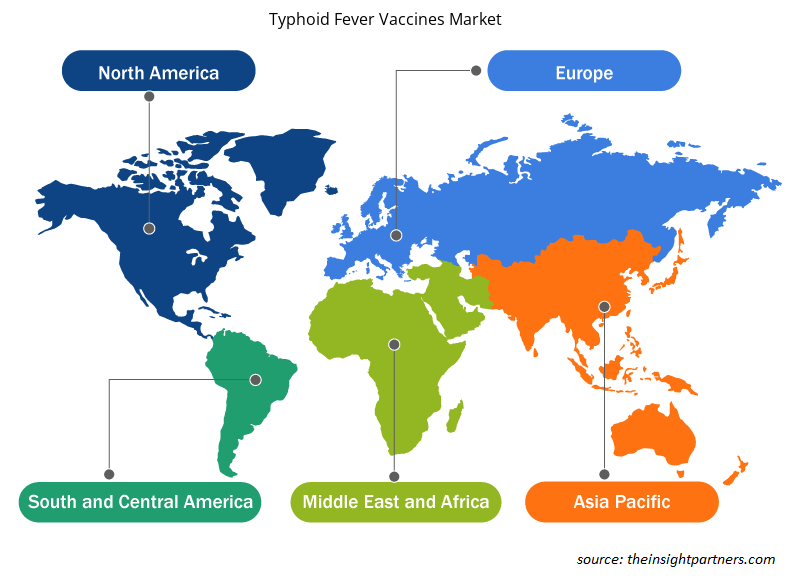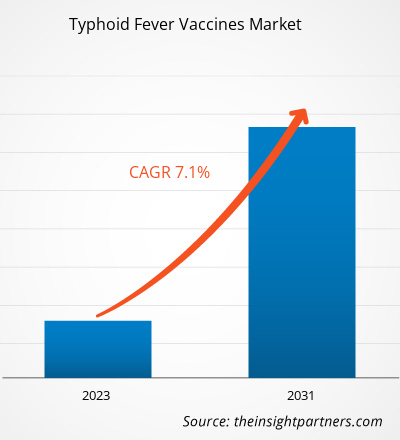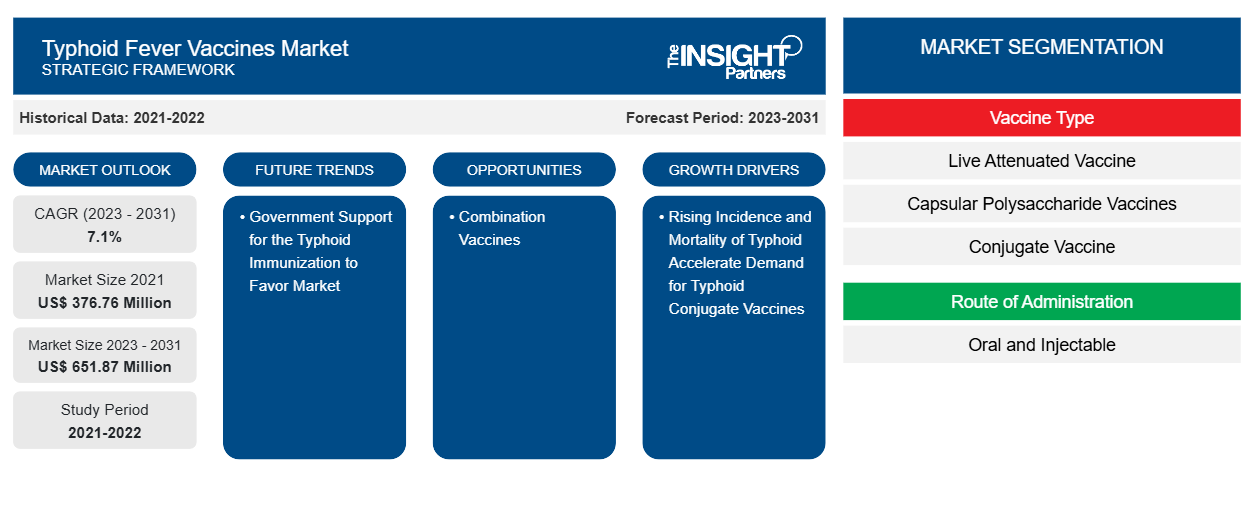El mercado de vacunas contra la fiebre tifoidea se valoró en 376,76 millones de dólares estadounidenses en 2021 y se espera que alcance los 651,87 millones de dólares estadounidenses en 2031. Se espera que el mercado registre una CAGR del 7,1% entre 2023 y 2031. Es probable que la penetración de las vacunas combinadas contra la fiebre tifoidea siga siendo una tendencia clave en el mercado de vacunas contra la fiebre tifoidea.
Análisis de mercado de vacunas contra la fiebre tifoidea
La creciente incidencia y mortalidad de la fiebre tifoidea acelera la demanda de vacunas conjugadas contra la fiebre tifoidea
Según el informe de marzo de 2023 de la Organización Mundial de la Salud (OMS), en 2019, se estima que 9 millones de personas enfermaron de fiebre tifoidea y que 110.000 personas murieron a causa de esta enfermedad cada año. Además, los viajeros corren un alto riesgo de desarrollar fiebre tifoidea, en particular en Asia y el África subsahariana. Por lo tanto, con el aumento de la incidencia y los casos de mortalidad, la demanda de vacunas contra la fiebre tifoidea es máxima. Por ejemplo, la OMS aconseja a los países que adopten la inmunización mediante vacunas conjugadas contra la fiebre tifoidea (TCV) para controlar la enfermedad en las regiones endémicas. La TCV es la primera vacuna contra la fiebre tifoidea adecuada para niños a partir de los seis meses de edad y es la opción de vacuna contra la fiebre tifoidea más preferida a nivel mundial. El Modelo de Mercado Global de Vacunas (GVMM) estimó que los ingresos totales del mercado de TCV en los países de ingresos medios (MIC) y los países de ingresos bajos (LIC) alcanzarían los US$ 44 millones, lo que representa solo una participación de mercado de aproximadamente el 14%.
Fuente: GVMM
Además, el Fondo de las Naciones Unidas para la Infancia (UNICEF) posee más del 95% de la cuota de mercado de la vacuna TCV, especialmente en África subsahariana y el sur y sudeste de Asia para los países de bajos y medianos ingresos. El UNICEF se encarga del suministro adecuado de vacunas TCV en África subsahariana y el sur y sudeste de Asia para reducir los casos de fiebre tifoidea de alta incidencia entre la población. Por lo tanto, el aumento de la prevalencia y la mortalidad asociadas a la fiebre tifoidea , la demanda y el suministro adecuados de vacunas tifoideas a los países epidémicos son los factores influyentes responsables del crecimiento del mercado de vacunas contra la fiebre tifoidea durante 2021-2031.
Descripción general del mercado de vacunas contra la fiebre tifoidea
La intervención gubernamental y las soluciones inteligentes para la administración de vacunas siguen influyendo significativamente en las vacunas contra la fiebre tifoidea. El apoyo gubernamental a la inmunización contra la fiebre tifoidea y el aumento de la incidencia y mortalidad por esta enfermedad son los factores más influyentes responsables del crecimiento del mercado de vacunas contra la fiebre tifoidea. Las vacunas combinadas contra la fiebre tifoidea son una tendencia clave para el crecimiento del mercado de vacunas contra la fiebre tifoidea. Los estudios preclínicos para desarrollar la vacuna trivalente glicoconjugada contra la salmonela tifoidea/no tifoidea brindarán una oportunidad de mercado lucrativa.
Personalice este informe según sus necesidades
Obtendrá personalización en cualquier informe, sin cargo, incluidas partes de este informe o análisis a nivel de país, paquete de datos de Excel, así como también grandes ofertas y descuentos para empresas emergentes y universidades.
-
Obtenga las principales tendencias clave del mercado de este informe.Esta muestra GRATUITA incluirá análisis de datos, desde tendencias del mercado hasta estimaciones y pronósticos.
Vacunas contra la fiebre tifoidea: factores impulsores y oportunidades del mercadoVaccinesMarket Drivers and Opportunities
Apoyo gubernamental a la inmunización contra la fiebre tifoidea favorecerá el mercado
El apoyo gubernamental a la inmunización contra la fiebre tifoidea acelera la demanda de vacunas a nivel mundial. Por ejemplo, el informe de la Mancomunidad de Australia revela que se recomienda que los niños menores de 2 años y los adultos reciban la vacuna contra la fiebre tifoidea si viajan a regiones epidémicas como el África subsahariana y el sur y sudeste de Asia. Además, los niños menores de 2 años y los adultos pueden recibir una dosis de la vacuna antitifoidea parenteral, y los niños mayores de 6 años y los adultos pueden recibir tres o cuatro dosis de la vacuna antitifoidea oral.
Además, en Canadá, la vacunación contra la fiebre tifoidea es obligatoria para los viajeros mayores de 2 años que viajen al sur de Asia, incluidos Afganistán, Bangladesh, Bután, India, Maldivas, Nepal, Pakistán y Sri Lanka. Por lo tanto, el apoyo gubernamental al programa de inmunización contra la fiebre tifoidea contribuirá más a que el mercado de vacunas contra la fiebre tifoidea crezca exponencialmente durante 2021-2031.
Estudios preclínicos para el desarrollo de una vacuna glicoconjugada trivalente contra la Salmonella tifoidea y no tifoidea: una oportunidad
En febrero de 2024, SK Bioscience y el Instituto Internacional de Vacunas (IVI) anunciaron que la vacuna conjugada contra la fiebre tifoidea desarrollada por SK Bioscience había obtenido la precalificación de la OMS para la adquisición pública de la vacuna por parte de las organizaciones de las Naciones Unidas, lo que supuso un impulso para el suministro mundial de TCV. Los resultados del ensayo clínico de fase 2 de la vacuna de refuerzo "SKYTYPHOID" revelan que las dos dosis de TCV administradas a bebés de entre 6 y 23 meses desarrollaron una fuerte respuesta inmunitaria.
Además, varios fabricantes están desarrollando TCV que se encuentran en la etapa preclínica. Por ejemplo, los fabricantes están desarrollando una vacuna trivalente contra la fiebre tifoidea y la fiebre no tifoidea glicoconjugada de Salmonella, especialmente para la población del África subsahariana. Además, el desarrollo de una vacuna contra la fiebre tifoidea y la fiebre paratifoidea A basada en un sistema de presentación de antígenos múltiples (MAPS) todavía se encuentra en la etapa preclínica y es una alternativa prometedora a la vacuna conjugada tradicional. Por lo tanto, los estudios clínicos para desarrollar una vacuna innovadora contra la fiebre tifoidea brindarán oportunidades de mercado lucrativas para los fabricantes que, en última instancia, impulsarán el mercado de las vacunas contra la fiebre tifoidea.
Vacunas contra la fiebre tifoidea
Análisis de segmentación de informes de mercado
Los segmentos clave que contribuyeron a la derivación del análisis del mercado de vacunas contra la fiebre tifoidea son la candidatura y los servicios.
- Based on Vaccine Type, the Typhoid Fever Vaccines Market is segmented into live attenuated vaccine, capsular polysaccharide vaccines, conjugate vaccine, others. The capsular polysaccharide vaccines may hold a larger market share in 2023.
- Based on Route of Administration, the Typhoid Fever Vaccines Market is bifurcated into oral and injectable. The injectable segment may hold a larger market share in 2023.
Typhoid Fever Vaccines Market Share Analysis by Geography
The geographic scope of the Typhoid Fever VaccinesMarket report is mainly divided into five regions: North America, Asia Pacific, Europe, Middle East & Africa, and South America/South & Central America.
North America has dominated the Typhoid Fever Vaccines Market. In North America, US accounts considerable share for typhoid fever vaccines. North America represents the largest typhoid vaccine market share and revenue due to rising healthcare expenditure and development of innovative vaccines through clinical trials are the most influential factors responsible for market growth. Asia Pacific is anticipated to grow with the highest CAGR in the coming years.
Typhoid Fever Vaccines
Typhoid Fever Vaccines Market Regional Insights
The regional trends and factors influencing the Typhoid Fever Vaccines Market throughout the forecast period have been thoroughly explained by the analysts at Insight Partners. This section also discusses Typhoid Fever Vaccines Market segments and geography across North America, Europe, Asia Pacific, Middle East and Africa, and South and Central America.

- Get the Regional Specific Data for Typhoid Fever Vaccines Market
Typhoid Fever Vaccines Market Report Scope
| Report Attribute | Details |
|---|---|
| Market size in 2021 | US$ 376.76 Million |
| Market Size by 2031 | US$ 651.87 Million |
| Global CAGR (2023 - 2031) | 7.1% |
| Historical Data | 2021-2022 |
| Forecast period | 2023-2031 |
| Segments Covered |
By Vaccine Type
|
| Regions and Countries Covered |
North America
|
| Market leaders and key company profiles |
|
Typhoid Fever Vaccines Market Players Density: Understanding Its Impact on Business Dynamics
The Typhoid Fever Vaccines Market market is growing rapidly, driven by increasing end-user demand due to factors such as evolving consumer preferences, technological advancements, and greater awareness of the product's benefits. As demand rises, businesses are expanding their offerings, innovating to meet consumer needs, and capitalizing on emerging trends, which further fuels market growth.
La densidad de actores del mercado se refiere a la distribución de las empresas o firmas que operan dentro de un mercado o industria en particular. Indica cuántos competidores (actores del mercado) están presentes en un espacio de mercado determinado en relación con su tamaño o valor total de mercado.
Las principales empresas que operan en el mercado de vacunas contra la fiebre tifoidea son:
- Inmunológicos de la India
- LBIP
- Finlay
- Incepción
- Panacea
- Biotecnología Bharat
Descargo de responsabilidad : Las empresas enumeradas anteriormente no están clasificadas en ningún orden particular.

- Obtenga una descripción general de los principales actores clave del mercado de vacunas contra la fiebre tifoidea
Vacunas contra la fiebre tifoidea: noticias del mercado y novedades
El mercado de vacunas contra la fiebre tifoidea se evalúa mediante la recopilación de datos cualitativos y cuantitativos posteriores a la investigación primaria y secundaria, que incluye publicaciones corporativas importantes, datos de asociaciones y bases de datos. A continuación, se incluye una lista de los desarrollos en el mercado de vacunas contra la fiebre tifoidea y las estrategias:
- En noviembre de 2023, la República de Corea anunció que una nueva vacuna conjugada contra la fiebre tifoidea, la "vacuna conjugada contra la fiebre tifoidea Bio-TCV (TCV)", se autorizará en Indonesia tras la aprobación de comercialización de Badan Pengawas Obat dan Makanan (BPOM), la autoridad reguladora nacional. La nueva vacuna, "Bio-TCV", es una vacuna conjugada de polisacárido Vi.
Informe de mercado sobre vacunas contra la fiebre tifoidea: cobertura y resultados
El informe “Tamaño y pronóstico del mercado de vacunas contra la fiebre tifoidea (2021-2031)” proporciona un análisis detallado del mercado que cubre las siguientes áreas:
- Tamaño del mercado y pronóstico a nivel global, regional y nacional para todos los segmentos clave del mercado cubiertos bajo el alcance
- Dinámica del mercado, como impulsores, restricciones y oportunidades clave
- Principales tendencias futuras
- Análisis detallado de las cinco fuerzas de Porter y PEST y FODA
- Análisis del mercado global y regional que cubre las tendencias clave del mercado, los principales actores, las regulaciones y los desarrollos recientes del mercado.
- Análisis del panorama de la industria y de la competencia que abarca la concentración del mercado, el análisis de mapas de calor, los actores destacados y los desarrollos recientes
- Perfiles detallados de empresas
- Análisis histórico (2 años), año base, pronóstico (7 años) con CAGR
- Análisis PEST y FODA
- Tamaño del mercado, valor/volumen: global, regional y nacional
- Industria y panorama competitivo
- Conjunto de datos de Excel
Informes recientes
Testimonios
Razón para comprar
- Toma de decisiones informada
- Comprensión de la dinámica del mercado
- Análisis competitivo
- Información sobre clientes
- Pronósticos del mercado
- Mitigación de riesgos
- Planificación estratégica
- Justificación de la inversión
- Identificación de mercados emergentes
- Mejora de las estrategias de marketing
- Impulso de la eficiencia operativa
- Alineación con las tendencias regulatorias























 Obtenga una muestra gratuita para - Mercado de vacunas contra la fiebre tifoidea
Obtenga una muestra gratuita para - Mercado de vacunas contra la fiebre tifoidea